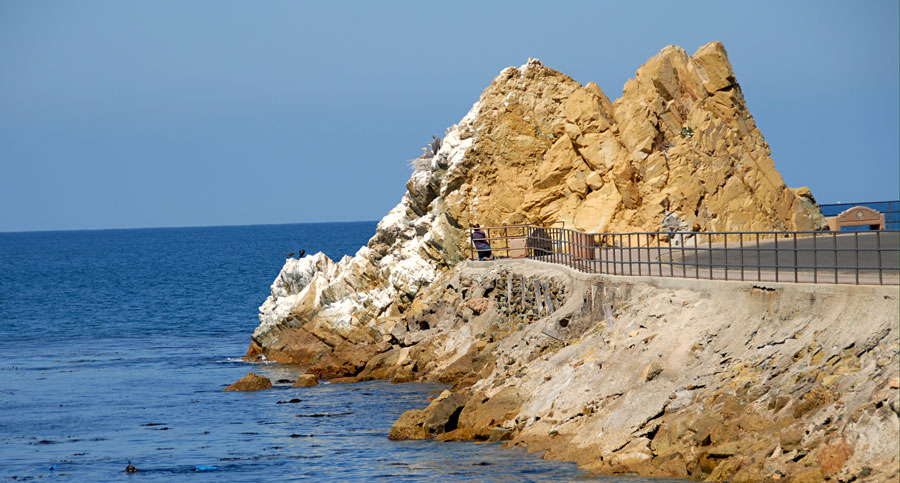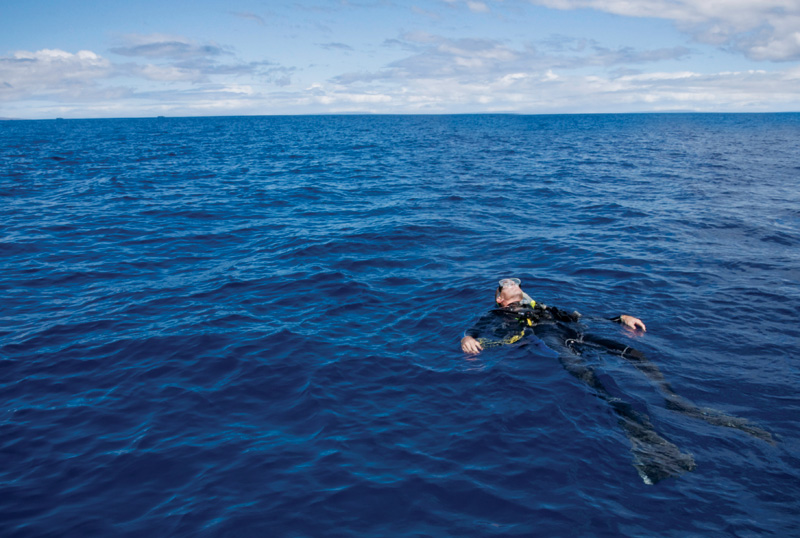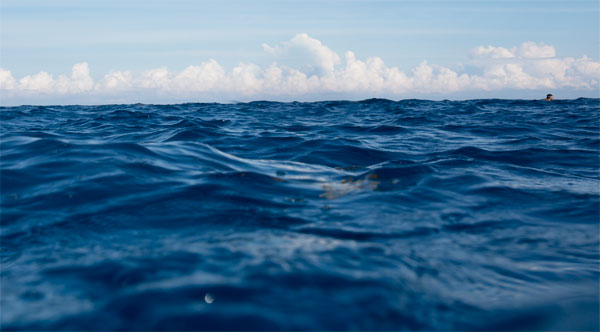“Make sure the anchor isn’t fouled up on the wreck, and it if is, move it off into the sand” were the last words from the captain as we gave the “thumbs down” sign, and began our descent to the wreck below.
Leveling out at 120 feet, we saw that the anchor was indeed caught up in the wreck, and would be almost impossible to reel back in after the dive. Between us, we managed to release the anchor and haul it off into the sand a short distance away, but still easily visible so we could find it at the end of the dive.
The wreck we were diving on is located in the San Pedro Bay area, which is home to a very busy shipping lane, the Catalina Express ferries and a large number of other private craft, so ascending back up our anchor line was a very high priority as we did not want to be drifting freely with just our safety sausage for protection.
After a very nice 30 minute dive, we slowly made our way back to where the anchor was supposed to be, only to find no sign of it. After a few minutes searching, my heart sank as I saw a small line in the sand caused by the anchor dragging across the seabed; for how long I had no idea.
ASCENDING WITHOUT A LINE
We followed the trail in the sand for fifty feet or so, but with still no sight of the anchor, were forced to abandon our search and perform a free ascent next to the busiest shipping lane in the U.S., and with a 15 minute decompression obligation, we couldn’t even ascend directly to the surface, making this ascent even more perilous.
We swam back to the wreck before starting our ascent, with the hope that our dive boat would still be over the wreck and would have a greater chance of locating us with our safety sausage. At this point, we encountered two rebreather divers who had also been unable to locate the anchor. We decided to ascend as a group to avoid spreading divers out all over the ocean, making it easier for the boat to retrieve us.
We began our ascent, moving as fast as we could yet still making our required decompression stops. The sausage was shot up from around 70 feet to give the boat a good chance of spotting it.
Reaching our twenty-foot deco stop (our longest), we all switched to our oxygen bottles for ten minutes of decompression, followed by a 6 minute slow ascent to the surface.
The CCR divers we were with had less of a decompression obligation than we did, so they had already surfaced by this point. 7 minutes into our deco stop, the boat still had not arrived to pick them up, which, given that we only had 11 divers in the water, was somewhat worrying. We opted to cut our decompression short in order to have a better chance of surfacing near the dive boat, and slowly ascended to the surface.
To my surprise, our dive boat was merely a speck on the horizon, and the formerly flat surface of the bay had now turned into 2-3 feet of wind-chopped surface and white caps.
Even worse, I could see we were heading directly into the path taken by the Catalina Express ferry, which would have little to no chance of avoiding us.
From this distance, there was simply no way our boat could spot our 3 foot sausage.
In rapid succession, two other sausages appeared on the surface (we had been the first team to descend, and therefore the first to surface) and I could only hope the other divers would minimize their decompression as much as safely possible.
MORE PROBLEMS SURFACE
One diver had a larger 6 foot sausage, which we inflated and waved above us, hoping to attract the attention of our dive boat, and it was at this point that the sharp pain in my right forearm started. At first, I thought it was just a twinge caused by me trying to move fast on the surface, but rapidly the pain increased, spreading toward my elbow, and I knew I’d taken a Type I DCS hit.
“I’ve taken a hit” I told the rest of the team, and I could see the level of concern in their eyes.
“How bad is it?”
“Bearable” I said, wincing as I deployed my Oxygen bottle to at least try to stop the pain from escalating.
Fortunately for us, our yelling and waving had attracted the attention of a passing fishing boat, which sped over to us. The occupants of the boat seemed quite surprised to see us drifting across the bay but were going to prove to be our salvation. We asked them to hail our dive boat on the radio, but after multiple attempts, they were unable to get a response.
The only solution was to have the fishing boat motor over to our dive boat and alert them, but that would mean the loss of our only protection from boat traffic, since the fishing boat was far too small for us to clamber into.
Meanwhile, the pain in my right arm had not increased, but definitely had not diminished, and I was forced to switch to my buddy’s oxygen tank, as I had drained mine.
The fishing boat sped off, and we settled in to wait. By this point, it seemed the other teams were going to complete their original decompression schedules instead of shortening, so we all grouped together around their sausages.
DIVE BOAT RETURNS
It seemed to take forever, but finally our dive boat surged into motion and started to head toward us. The fishing boat was faster though, and thankfully came back to protect us.
“Are there any more of you?” they asked us, and luckily someone realized that one teams sausage had not inflated properly and was almost impossible to see from any distance away.
“Over there” he said, directing the fishing boat, which hovered over that team to mark their location.
From then on, things happened very fast. Divers started to surface, we stripped off our decompression bottles, handed them up we made our way back onboard the boat.
Finally back onboard, the surface oxygen wasn’t helping. I had had similar pains once before and found that Ibuprofen helped far more than oxygen, and this proved to be the case again as the pain subsided less than 20 minutes later.
During the boat ride home, the whole story of what happened became much cleared.
When we had untangled the anchor, it hadn’t bitten into the sand properly and almost instantly started to drag across the sand, moving further and further from the wreck.
As subsequent teams descended, all were able to follow the anchors trail to the wreck, but by the time it came to surface, the boat was too far away for us to swim to the anchor (over half a mile).
Since there are relatively few visual reference points on this area of the ocean, and the boat crew was also preparing food, it took some time for them to realize they were no longer anchored on the site. The main reason the boat crew was alerted (except being hailed by the fishing boat) is that we always try to give the captain an accurate runtime of our dive. In this case, we had exceeded our 55 minute planned time, and since we are virtually always on time, the captain was alerted.
LESSONS LEARNED
The lessons learned from this are many:
1) If you are moving the anchor to free it from obstructions it, make sure it bites into to sand.
2) Since we had planned to return up the anchor line, it may have made more sense to move it at the end of the dive, not the beginning. The downside here is that had we failed to return, a subsequent dive to free the anchor may have been needed.
3) Some teams saw the anchor was skipping and decided to continue their dive. It would have been better for them to ascend up the skipping anchor and alert the boat.
4) Our 3-foot (1M) safety sausages are only really useful with little or no swell. 6-foot sausages would have been better here (but would still not have been visible to our dive boat).
5) The boat didn’t notice they were drifting. A portable GPS, or an alarm on the boat GPS would have helped here
6) Sometimes it’s better to cut decompression (or safety stop) short or omit it altogether and surface earlier. Had we not done so, who knows how far we would have drifted, and if we would have been within range of a fishing boat to come to our rescue.
7) Check your safety sausage for leaks regularly and fix them (I think the reason one team’s sausage didn’t inflate correctly).
8) Giving accurate maximum runtimes to the boat captain is a valuable logistical and safety tool.
We learned a lot from this experience, and hopefully you can too.
Dive safe.
RELATED STORIES:
Have You Hugged Your Safety Sausage Lately?
Make Every Scuba Dive Safer with the Nautilus Lifeline GPS VHF Safety Radio
Story by Nick Ambrose, independent contributor
This story originally ran in our Jan/Feb 2011 issue of California Diver Magazine
.



